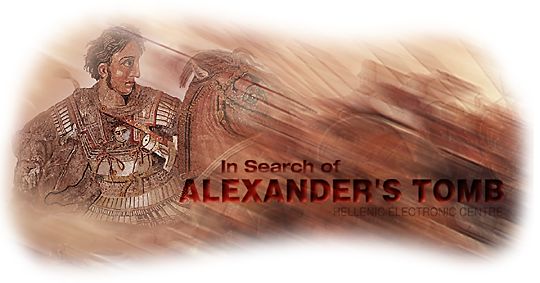
Alexander the Great (Alexander III of Macedon (Greek: Αλέξανδρος) 20/21 July 356 BC – 10/11 June 323 BC), was a king of the ancient Greek kingdom of Macedonia. A member of the Argead dynasty, he was born in Pella — a city in Ancient Greece, near today's Thessaloniki. He succeeded his father King Philip II to the throne at the age of 20.
The life and times of Alexander the Great make for fascinating reading, even in modern times. Not only have they excited the imagination of many, but they have also triggered expeditions in search of his tomb. By all ancient accounts, however, Alexander the Great was burried in Alexandria by KingPtolemy II. An account of Alexander's visit during his lifetime to the oracle of Ammon at the oasis of modern-day Siwa, as well as of the adventures of the king's remains from Babylon to their final resting place in Alexandria, follows.
Alexander in the Oasis of Siwa | The Location of the Tomb: Facts & Speculation | The Aftermath: The Burial of Alexander the Great
Alexander's visit to the Oracle of Ammon at Siwa was, and still is considered as one of the most fascinating events of his reign. It was so widely publicized in antiquity, that king Lysimachos of Thrace, one of Alexander's successors, struck one of the first issues of posthumous silver tetradrachms in the name of Alexander, featuring the portrait of the Macedonian king on the obverse, bearing the horns of Ammon on his head.
According to several ancient historians, Alexander claimed towards the end of his life that he was actually the son of Ammon/Zeus and not of Philip II of Macedon. We have no way of knowing whether such a claim was ever made by Alexander himself. We do know, however, that the Greeks were immensely skeptical about these rumours, because they generally opposed the deification of a mortal during his lifetime. These attitudes may be reflected centuries later in the twelfth Dialogue of the Dead by Lucian, the great satirical author of the Roman period (2nd century A.D.). In it, Alexander is portrayed as one among the dead of the Underworld. He meets Philip, his biological father, there who gently scolds and mocks him for denouncing his parentage and claiming that he was the son of Ammon.

Silver Tetradrachm featuring Alexander-Ammon struck by king Lysimachos of Thrace (301 281 B.C.).Obverse: Head of Alexander with the horns of Ammon.Reverse: Seated Athena holding victory with the legend: BASILEOS LYSIMAHOU.American Private Collection.
Accounts of Alexander's trip to the Oasis of Siwa have survived in Strabo's Geographica (Strabo, 17. C 814) and in Arrian. The latter claims that he drew his information mainly from Ptolemy and Aristoboulos who were present at Siwa at that time. One may wonder why Arrian did not consult Kallisthenes who was, after all, the official court historian of Alexander. This remains a mystery, but one may speculate that Kallisthenes was either already dead in 331 B.C. or that his account was full of the inevitable inaccuracies and flatteries of a court historian. On the other hand, Ptolemy wrote his history after Alexander's death, when he had already established his rule over Egypt and did not stand to profit from lying. Autoboulos also wrote after the death of Alexander. Arrian may also have chosen the accounts of Ptolemy and Autoboulos over that of Kallisthenes because the two former agreed with each other. It seems that other late historians, like Diodoros from Sicily (17.50.6; 51.4) and Plutarch, followed the tradition of these two early historians.
The Oracle of Ammon is located in Libya. Although it was considered as one of the most prominent and reputed ancient oracles and enjoyed "international" reputation, no Egyptian pharaoh before Alexander had ever visited it. So why did Alexander make the honors? The answer is obvious if one takes into account the fact that the Libyan Oracle of Ammon was very well-respected in Greece. Ancient Greek authors ranked it third in importance after the sanctuaries of Zeus at Olympia, the home of the Ancient Olympic Games, and the sanctuary of Zeus in Dodona.
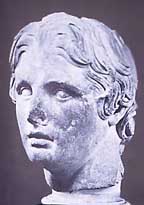
Marble head of Alexander the Great from Pergamon. Hellenistic period.
Alexander set off for the Oracle of Ammon at Libya in 331 B.C. In order to reach it, he had to cross the desert and face many dangers. According to our sources, the chief priest of Ammon there welcomed Alexander by calling him "son of the God." He then allowed him access to the Adyton of the temple, a privilege usually reserved exclusively for the priests. Alexander's entourage was only allowed to enter the front yard and receive their oracles there. Only Alexander received his oracle personally in the Adyton.
It is obvious that inaccurate rumours, gossip, and endless speculation on Alexander and his visit to the Ammoneion of the Libyan desert had mingled with the facts by the time that Plutarch wrote his biography of Alexander. Plutarch cites an unnamed source, according to which Alexander allegedly posed two questions to the priests of Ammon:
1) Whether any of Philip's assassins got away unpunished; and 2) whether he would conquer the entire world. To both these questions, the Oracle answered in the affirmative. Plutarch doubted the validity of his unnamed source and agreed with the reports that Arrian probably also used: that Alexander kept his discussion with the priests a secret, although he allegedly did write to his mother Olympias back to Macedonia promising to reveal his oracles to her alone upon his arrival back home (cf. Plutarch, Alexander, 27. 5-7; Arrian, 3.4.5).
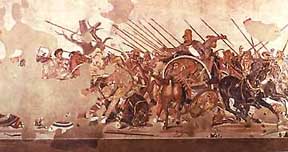
Mosaic featuring the Battle of Issos. Roman copy of Hellenistic original.
Another interesting point that in Plutarch's account of Alexander's visit to the Ammoneion of Siwa, the author relates that historians before him had already challenged the accuracy of the alleged proclamation of Alexander as son of Ammon by the priests and had suggested their own interpretation of the disturbing rumors on the Macedonian king's divinity. According to these unnamed sources, the chief priest of Ammon who was not very fluent in Greek, instead of correctly addressing Alexander as "O paidion" (=oh, my child!), he mistakenly called out instead: "O paidios" which could also be interpreted in Greek as "O pai Dios" (=oh, child of Zeus!).
Rational explanations did not appeal to the public, however. Our reader will remember the general evaluation of the Roman historian Curtius Rufus by modern scholarship as an unreliable source. This author relates a charming though fictitious story, according to which Philip II of Macedon was allegedly aware of the fact that Zeus was the biological father of Alexander (Rufus, 4.7.23-28). The chief god of the Greek Pantheon frequently visited Olympias in the night in the form of a snake. Philip II found out about this by peeping through the keyhole while his wife had intercourse with Zeus. His behaviour was considered sacrilegious by the gods, who then punished him by causing him to eventually lose the eye with which he watched Zeus's amorous adventures with the queen of Macedon! Curtius Rufus even stretches this story further by claiming that Alexander murdered Kleitos, his father's general, because the latter did not believe that his king was in reality the son of Zeus (Rufus, 6.9.17; 6.10.23; 8.7.13; 8.8.14; 8.5.5).
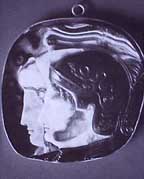
Cameo featuring the heads of King Ptolemy II Philadelphos and his wife/sister Arsinoe II. Vienna
Alexander the Great did proclaim his divinity towards the end of his life and ordered his subjects to worship him as god. It is also true that the Macedonian kings of the Argead dynasty who ruled before Alexander, traced their descent to the Greek mythical super-hero Heracles who was the son of Zeus. In that sense, it is true that Alexander claimed Zeus as his forfather, but it appears unlikely that he launched a propaganda campaign in order to promote any "blood" association between the king of Macedonia and Zeus/Ammon. Alexander reportedly sacrificed to Zeus before the Battle of Gaugamela for good luck, according to Plutarch who drew this information from Kallisthenes. This act, however, was not out of the ordinary, as Zeus was, after all, the chief god of the Greeks who frequently sacrificed to him at times of war for good luck (cf. Plutarch, Alexander, 33.1; Tarn, Alexander, p. 352 ff.; for the importance of Zeus see Xenophon, Apologia Sokratous). And in his long speech to his army which threatened mutiny at Opis, Alexander repeatedly mentioned Philip II as his father (cf. Arrian, Anabasis, 7.9).
Select Modern Bibliography on Alexander's Visit to the Ammoneion at
Siwa
A. B. Bosworth, "Alexander and Ammon," Greece and the Eastern
Mediterranean in Ancient History and Prehistory. Studies Presented to
Fritz Schachermeyer on the Occasion of his Eightieth Birthday, edited by
K. H. Kinzl, (Walter de Gruyter; Berlin, New York, 1977), pp. 51 - 75
The information that Alexander the Great allegedly asked at his deathbed to be buried at the Ammoneion of the Libyan Oasis in modern-day Siwa, is mentioned by the later historians Diodoros (18.3.5), Curtius Rufus (10.5.4), and Justin (12. 15.7). Bosworth, a modern historian, has suggested that Diodoros who did not name his source for his account of Alexander's death and burial, probably drew his information from the History of Hieronymos of Kardia (late 4th century B.C.; see above). Although there are no surviving reports from historians who were eye-witnesses of the last days of Alexander, it is not improbable that Alexander did in fact wish to be buried in Egypt. One should not forget, however, that modern historians have made an equally plausible and attractive case, according to which, Alexander wished to be buried at Aigai with his predecessors.
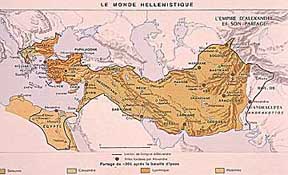
Alexander's Empire at its largest, in 323 B.C.
But let us take a look at the facts. On his deathbed, Alexander allegedly gave his ring to his general Perdikkas, thereby appointing him regent of his huge empire until queen Roxane gave birth to their child. Roxane eventually did indeed give birth to a son, Alexander IV, who stood to inherit his father's territories. Alexander the Great's generals had different plans, however, and aimed at promoting their own interests for succession. Very early on, they openly challenged the legitimation of Alexander IV's designation as heir of his father. Our readers will surely be familiar with the way the Greeks viewed all non-Greeks whom they called "Barbarians." And Alexander IV was, after all, half-Bactrian, half-Greek. The years from 323 to 301 B.C. saw endless conflicts among Alexander the Great's successors which ended with the parceling out of the Macedonian conqueror's empire and the creation of the first Hellenistic kingdoms. During these turbulent years, Alexander IV and his mother Roxane were assassinated by Cassander who then usurped the throne of Macedonia and married Thessaloniki, Alexander the Great's sister in order to legitimize his power.
In the struggle of Alexander's generals for succession, the body of the conqueror played the role of a symbol which would confirm the newly acquired power of some of them. Perdikkas, according to our sources, sent the mummified remains of Alexander the Great to Aigai, the old Macedonian capital, for burial. He had a magnificent funerary cart constructed for this purpose. The body itself was placed in a gold anthropoid sarcophagus which was in turn encased in a second gold casket and covered with a purple robe. Alexander's coffin was placed, together with his armor, in a gold carriage which had a vaulted roof supported by an Ionic peristyle. The decoration of the carriage was very rich and is described in great detail by Diodoros (18.26.3). A good tentative reconstruction of the funerary cart has been proposed by the modern archaeologist Stella Miller (see bibliography below). This scholar by no means claims that her reconstruction is accurate; she rather suggested it in order to help scholars visualize what is discussed by Diodoros.

The breakdown of Alexander's Empire following the Battle of Ipsos in 301 B.C. (after Duby)
Very early on, Ptolemy had realized that the breakdown of Alexander's Empire was inevitable, and he wished to secure the wealthy territory of Egypt for himself. He therefore organized an attack against Alexander's funerary procession and intercepted the body of his former master which he then buried in Memphis, the old capital of Egypt. This event caused the final breach in the relations of Ptolemy with Perdikkas and is described by all ancient historians: Arrian (7.26.3); Diodorus (17.117.4; 18.1.4; 18.26.3); Curtius Rufus, 10.5.5; and Justin, 12.15.8). Diodoros mentions that Alexander's funerary procession was indeed destined for the Ammoneion of Libya in modern-day Siwa, but there is not a single ancient historian to claim that Alexander was in fact ever buried there. I will take this information a little further. By the time that Ptolemy stole Alexander's mummy from Perdikkas, thereby infuriating the latter, he had established his control over Egypt. It seems therefore unlikely that Perdikkas would be ever so naive as to not have guessed Ptolemy's ambitions and the role that Alexander's body would play in Ptolemy's dynastic propaganda. Perdikkas, at least in the beginning, seems to have sincerely tried to hold Alexander's Empire together and preserve it for Alexander IV. It is therefore highly unlikely that he would ever decide to bury Alexander in Egypt instead of Aigai, the traditional burial place for Macedonian kings and an area that he himself controlled. On the other hand, if Alexander's body was ever destined for Siwa for burial, Ptolemy would not go to any pains in order to steal it from Perdikkas, since the body was being transported to Egypt anyway and would therefore be easily accessible to him. If we add to this information the ancient reports about the increasing dissatisfaction of the Greeks with Alexander's adoption of foreign customs from the territories that he conquered, one can plausibly wonder whether the ancient reports of his alleged wish to be buried at the Ammoneion of Libya can be accurate.
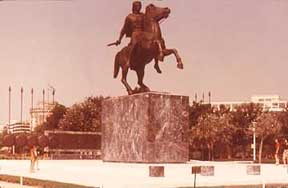
Modern statue of Alexander the Great, Thessaloniki.
One may therefore plausibly conclude that Alexander wished to be buried in Aigai, next to his ancestors despite the "internationalist" ideas of the Macedonian conqueror for the creation of a multi-national empire where diversity and individuality would be respected. Alexander always remained a Greek and was on his way back home to Macedonia when he died suddenly. Perdikkas, who by allaccounts conformed to his former master's wishes and protected his widow and infant son, then intended to bring his body to Aigai. Ptolemy on the other hand, had other plans. He had established his control over Egypt and decided to use the body of Alexander as asymbol in order to legitimize his position. He intercepted the mummy by attacking the funerary procession which headed eastwards and buried it at Memphis. According to Diodorus who describes the tomb of Alexander in Memphis in some detail, the monument which was constructed by Ptolemy I there, was in the traditional Egyptian style.
Alexander's posthumous adventures were far from over. Ptolemy II Philadelphos (293-246 B.C.), the son and successor of Ptolemy I Soter, transported the body of Alexander from Memphis to Alexandria, the capital of his kingdom. The ancient authors are very clear on this last point: Alexander was buried for the last time in Alexandria. A cult of Alexander-Ktistes (= founder of the city) developed in the area of his tomb which was henceforth referred to as "Sema" or "Soma," which in ancient Greek meant "the Body." The term "Sema" was not restricted to the actual location of the tomb of the Macedonian conqueror, but gave its name to the entire district around it. Several ancient authors mention a district of Sema in Alexandria, among whom are Achilles Tatius (3rd century A.D.); Zenobius (2nd century A.D.) who places the district and the tomb in the middle of the city of Alexandria; Strabo (1st century B.C./1st century A.D.); Lucian (2nd century A.D.); Suetonius (2nd century A.D.); and Pseudo-Kallisthenes (3.34).
The cult of Alexander in his capacity as Ktistes (= founder) of the city of Alexandria is mentioned by many sources. The Ptolemies of Egypt not only encouraged the public fascination with the Macedonian conqueror; they also tried to incorporate their own ruler cult to Alexander's. Already in the early third century B.C. Ptolemy I Soter spread rumours, according to which he himself was not the son of Lagos, but the illegitimate son of Philip II and therefore Alexander's half-brother and legal successor. Our interested reader can track down all ancient reports on this aspect of the Ptolemaic propaganda in P. M. Fraser, Ptolemaic Alexandria, Vol. I, p. 215 ff. Ptolemy I was deified after his death and worshipped together with Alexander the Great, according to ancient reports. Their statues were prominently displayed, among other places, in the Great Parade which opened the Ptolemaia Festival, a celebration that was founded by Ptolemy II in honor of his deceased father Ptolemy I in 283 B.C. (cf. Kallixeinos [3rd century B.C.] in Athenaios, Deipnosophists, 201 D; Ellen Rice, The Grand Procession of Ptolemy Philadelphus, [Oxford, 1981)].
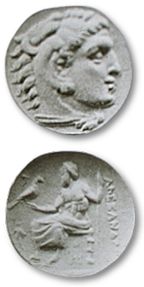
Alexander lifetime silver tetradrachm.
Obverse: Head of young Heracles with lion skin.
Reverse: Seated Zeus holding eagle and legend: ALEXANDROU.
American Private Collection.
The tomb of Alexander the Great in Alexandria, where his body probably lay in public display, was visited in antiquity by important personalities, scholars, and common tourists alike. We hear that Alexander's mummy was originally laid to rest in a gold sarcophagus. It was king Ptolemy IX (116-107, 87-81 B.C.), one of the worst successors of Ptolemy I, who replaced Alexander's sarcophagus with a glass one, and who melted the original down in order to strike emergency gold issues of his coinage. This report is related by Strabo (17. C 794), who visited Alexander's tomb himself in the first century A.D. The subsequent mismanagement of Egyptian affairs by Ptolemy IX's successors, as well as the economic collapse of the kingdom, caused by an incompetent administration, made it impossible for the Ptolemies to restore Alexander's gold sarcophagus. Diodoros from Sicily visited Alexandria and Alexander in ca. 60 B.C. and has preserved an exciting description of the tomb for posterity (18.26.3; 28.2-4).
Alexander's illustrious visitors included Julius Caesar who visited Alexandria in 45 B.C. and went to pay his respects to the legend that he idolized. Caesar's visit is described by Suetonius (Caesar, VII) and Lucian (X.19), both of whom lived in the second century A.D. When Augustus defeated Marc Anthony and Cleopatra at Actium in 31 B.C. and subsequently conquered Alexandria in 30 B.C., he was taken to see Alexander on whose body he dedicated a wreath. Augustus's guides offered to take him next to the tombs of the Ptolemaic dynasty which were located nearby. To that Augustus answered that he came to see a king and not dead people (Dio Cassius, Roman History, 51; 2nd-3rd centuries A.D.). Dio includes an apocryphal anecdote in his report of Augustus's visit to Alexander: As he bent over to kiss the great conqueror, Augustus accidentally broke Alexander's nose.
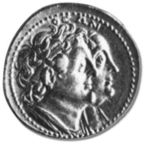
Heads of deified Ptolemy I Soter and his wife Berenice with the legend: THEON.
Reverse of silver tetradrachm struck by Ptolemy II Philadelphos (281 246 B.C.)
American Private Collection.
Several other Roman emperors reportedly visited the tomb of Alexander in Alexandria: Caligula, according to Dio, went to Alexandria, paid a visit to the Sema and left with Alexander's cuirass (Xiphilinus, Epitome of Dio's Roman History). Septimus Severus (early third century A.D.) eventually closed the tomb to the public because he was nervous about its safety under the hoards of tourists who rushed to visit. The last reported imperial visit that we know of was made by Caracalla (3rd century A.D.), who believed that he was Alexander's reincarnation. This emperor reportedly dedicated a treasure of offerings to the body of Alexander, among which was a mantle, rings, and other jewelry. This last visit was reported by the historians Herodian (Tes Meta Markou Basileias Historion Biblia 4, 8) and Ioannes Antiocheus (ca. 108-238 A.D.). In the Early Christian period, people appear to have had knowledge of Alexander's burial in Alexandria, as is evident from the depiction of Saint Sisois on icons in front of Alexander's corpse contemplating the tragedy of human mortality.
In conclusion then, there is ample reliable evidence to suggest thatAlexander was in fact laid to rest in Alexandria. There are reports on the location of the tomb and on its visitors from the Hellenistic to the Late Roman period. Some of these authors, like Diodoros and Strabo, visited the tomb themselves. No ancient source suggests that Alexander was ever buried at the Ammoneion of the Libyan desert in modern-day Siwa. To argue otherwise and initiate endlessspeculation based on no evidence whatsoever, is only counter-productive. It is our fond hope that we have been able to present our readers with a solid and unbiased account of all the information that is furnished by the primary sources.
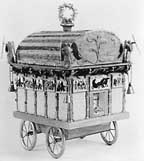
Tentative three-dimensional reconstruction of Alexander the Great's funerary cart by Stella Miller based on the descriptions of ancient authors.
Courtesy of Stella Miller.
Copyright © Hellenic Electronic Center and Elizabeth Kosmetatou (author), 1998. All rights reserved.